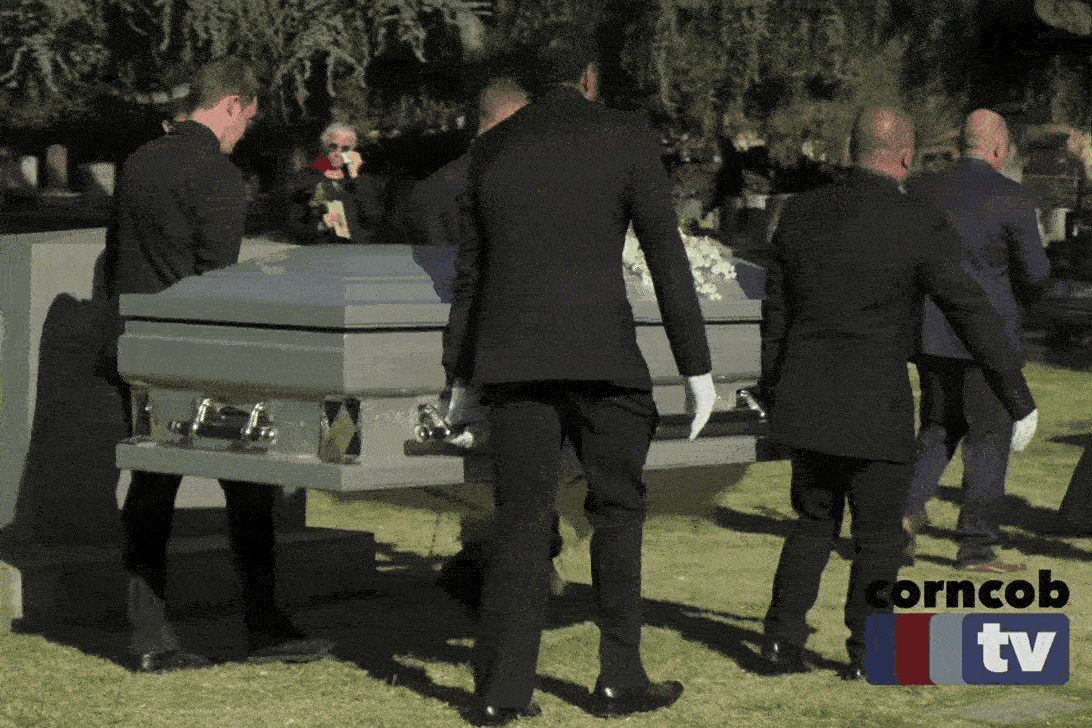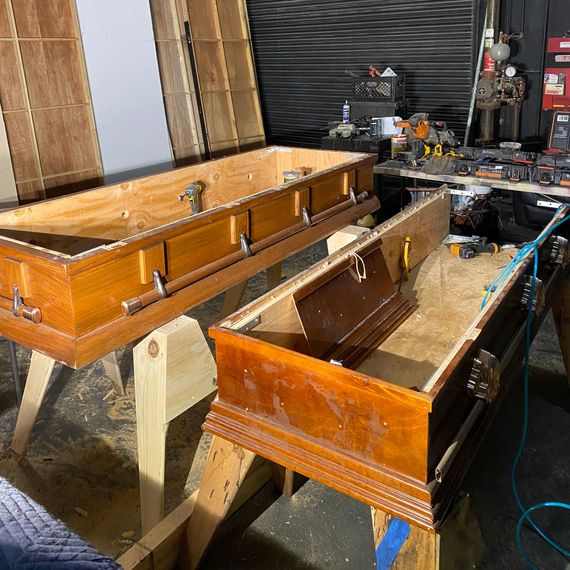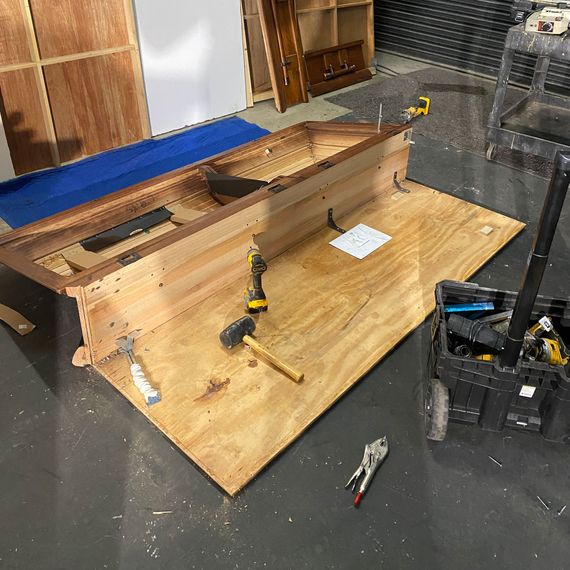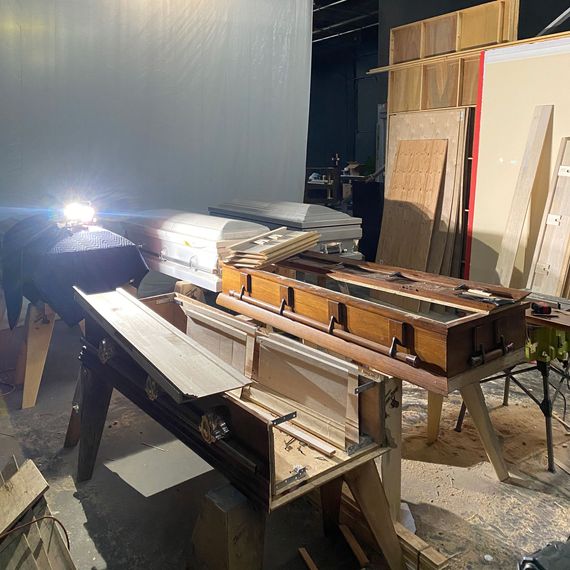
One of the very first sketches that kicks off the second season of I Think You Should Leave is a PSA for a little-known television network called Corncob TV, which — according to a network representative played by Tim Robinson — is at risk of being removed from Spectrum’s channel offerings. That’s despite the success of its most popular show, Coffin Flop. “They’re saying Coffin Flop is not a real show,” Robinson declares. “It’s just hours and hours of footage of real people falling out of coffins at funerals.” As Robinson’s pleas for Spectrum to take Coffin Flop seriously and save Corncob TV escalate into threats of violence, more and more clips play of coffins bursting open to spill human remains onto the ground. It’s a perfect combination of everything that makes an I Think You Should Leave sketch great: a spectacularly dumb, uncomfortable premise taken extremely seriously and justified by nothing but Robinson’s screaming that this is all normal and fine and also not his fault.
The making of Coffin Flop was a challenge presented to directors Jeffrey Max and Zachary Johnson, who previously worked on ITYSL’s season-one sketch “Fenton’s Horse Ranch,” in which every horse had a “smaller penis than a human man.” (For the record, Max still has a “very authentic horse phallus” from that shoot.) “When we read the script — Tim’s monologue was like six, seven pages — we were like, ‘We need to see so many broken coffins,’” Johnson remembers. Their initial concept was to create a hidden-camera-style show that would allow people holding iPhones to cover the falls from several angles in order to generate as much footage as possible using the least amount of coffins. “Because realistically, how many coffins are we going to be able to break in a given day?” Johnson says. It was an idea that Robinson and ITYSL co-creator Zach Kanin dismissed immediately. “They were very certain that it should be like professional-looking footage,” Max says. “There were crews getting sent out to funerals to film them; they’re not hiding. They’re just there to film the funerals in case a body falls out, and so that was the aesthetic.”
Coffins are notoriously heavy, sturdy things designed to seal a human body off from the forces of nature. So to create coffins that could repeatedly burst open seemingly at random was the first hurdle for lead prop maker Joe Holliday. “I got five coffins, and I realized that for the amount of breaks that we’re going to have to do, I’d have to make everything really modular,” he says. “I had to remove anything with sharp edges or any bolts that might be sticking through. [Coffins] are designed for people that don’t feel pain anymore, so if you’re putting live people in them, you have to make sure that it’s going to be safe.” Using balsa wood, Holliday replaced the parts of the coffins from which the bodies would need to burst and scored the wood for extra-easy breakage. “We had so many breaks, we wouldn’t be able to get as many coffins as we had breaks,” Holliday says. “It’s not like we could just throw away the coffins when we were done. So we had to figure out a way to very quickly change out the breakaway panels.”




To figure out how performers would move inside the coffins, Holliday worked with the show’s stunt coordinators, Nito Larioza and Lou Simon. (Larioza is a veteran of both the Marvel and DC cinematic universes, and Simon has worked on everything from The Lost World to Fear the Walking Dead.) “When you get put in a coffin, there’s a lot of people that can’t breathe. They get claustrophobic,” Larioza says. “I had to find small people that fit the coffin.” The weight of the coffin meant that the performers would need to be as light as possible, and smaller performers would also have the room to drop themselves off of the special railings Holliday had added to the insides of each coffin and then break through the wood below.
Through multiple tests performed by Larioza himself, the look of the drop was refined. “It was just a process of changing out the materials that were used to give us the most splintery, most visually appealing bottom break,” Johnson says. Eventually, hamster bedding was added to the bottom of the coffins to create a bigger field of debris.
The next challenge was finding performers who could pull off each fall. “I wanted to make sure that I got tough kids in there that were willing to do it,” Larioza says. “When I was looking for people for this gag, there were a lot of people that wanted to do it. It was a unique gag. It wasn’t a fight. It wasn’t a car gag, it wasn’t fire. It was a coffin job. And you rarely see that.” Simon adds that it was crucial to hire performers who were experienced and able and willing to do multiple takes. One performer the production relied on repeatedly was LJ LaVecchia, a 28-time world-champion jump-roper and stunt performer, who was recruited for his ability to fall down stairs extremely well. “Whenever we had [a fall] that we thought might, uh, you know, result in us needing a genuine coffin, we threw LJ in there,” Johnson says.
In order for the audience to clearly see the fall happening, the number of pallbearers for each coffin had to be reduced from the standard six to only four, making it extra burdensome. “I can’t have extras being the pallbearers and holding the casket, because anything can happen,” Larioza says. “So I hired stunt people, people that I knew that were strong, that I trust that I knew could hold that.” (Larioza hired his brother as one of the sketch’s pallbearers.) Another aspect to prepare for was the locations of the drops, which Simon had scouted with the crew in advance. “I’m measuring, Okay, this is a two-foot drop, a three-foot drop, a four-foot drop,” he says. Grass was the easiest surface to drop on, while concrete surfaces required pads that would prevent the performers from being nude. (According to Robinson’s character, “One out of every five of ’em are nude.”)
When it came time for people to actually start dropping out of coffins, the crew had a single day — February 18, 2021 — at Mountain View Cemetery in Altadena, California, a cemetery considered particularly amenable to film shoots, having served as a location for CSI, The Office, and Six Feet Under. It came complete with an empty grave reserved specifically for film shoots, which was helpful when it came time to film the coffin flop where a body drops straight into an open grave. “That’s their ‘movie grave’ they call it or something, so that if you need a graveside thing, you don’t have to do it at a real person’s headstone,” Max says. But since it was winter, the crew had limited daylight hours in which to get every necessary shot. “That day was crazy,” Holliday recalls. “We were moving through that cemetery so quickly.” Holliday estimates the crew performed 28 falls that day, enough that he ran out of the breakable bottom panels and had to start repairing the ones that had already been broken to use again. It was a level of destruction that surpassed his time creating all the desks that got smashed during the fifth season of The Eric Andre Show. “The entire season, I think we only did like 24, maybe 25 [broken desks]. So we broke more coffins in a day than we broke desks on that other show.”
Background actors were also key in selling the effect. “The actual production sound was me going, ‘Three, two, one, fall,’ and it’s pretty unspectacular,” Johnson explains. “But at the end of our day, we gathered up all of the funeral attendees, and we just recorded a bunch of gasps and ‘Jesus Christ!’ and stuff like that, just layering all that over in the edit.” Max adds that there were “some of them that were really doing some heavy lifting, I think, in their reactions, which I appreciated.”
The short shooting schedule presented a challenge for one of the sketch’s more complex falls: a scene in which a body falls out of a coffin and slides down a marble staircase. It’s the fall LaVecchia had been specifically hired to perform, and the one both Simon and Larioza agree was the trickiest. The stunt had been performed successfully without a coffin by Simon on a location scout. “That was the first time I had seen [the staircase],” Simon says. “I had a pad in my bag and I said, ‘You know what? Since we’re all here looking at these beautiful steps, why don’t I just do it?’”
But on the day of shooting, the added complication of LaVecchia actually having to exit the coffin dead-body style and complete the full slide proved tricky. To keep the stunt as safe as possible, Holliday rigged a hinged bottom that would allow LaVecchia to slide out instead of dropping straight down. Complications arising from the coffin having to tilt down the stairs, however, prevented him from being able to gain enough momentum to slide all the way down the stairs safely after two takes. “And I was kinda like, ‘I want a third take! I want a third take!’” LaVecchia recalls. “But I don’t think we had time or the coffin resources.” In the final edit, the camera cuts away from LaVecchia fast enough that the sliding effect remains. “They cut it real quick, but it still looks funny,” Larioza says.
LaVecchia would get another chance to perform an iconic coffin fall, however, when he agreed to be a nude body that falls from a coffin and rolls down a hill. (“I thought we were maybe pushing things a little too silly with that one,” Johnson says.) The drop was mostly painless, and LaVecchia was provided a dance belt for modesty’s sake, but the roll in the grass did leave him feeling itchy. He also makes an appearance as the body that drops from the pallbearer’s shoulder height, which he was able to wear pads for, thankfully.
The trick to falling like a dead body, according to LaVecchia, is to try and hit the ground with your shoulders first, “because if you land with your butt first, sometimes it can whiplash your head into the ground.” Larioza adds that you “can’t really know when the impact is going to happen; you’re going to just have to tuck in your chin and just go with the fall.” Simon offers an even simpler take: “Really, gravity is what it is.”
Creating and coordinating a bunch of coffin flops was actually something of a treat for Larioza and Simon, who are more accustomed to big feature films where they have less input in how stunts come together. “I get to be creative,” Larioza says. “I get to talk to them and brainstorm with them and tell them what I think, and hire my friends. Sometimes that’s more fulfilling, you know what I mean?”
“I think that’s just the beautiful thing as far as what we do: Every project is just standalone for what it is,” Simon adds. “I don’t think I’ve done over ten coffin drops in one day for any other show, so that’s a first.” Johnson says that “everybody was firing on all cylinders” during the shoot and considers Coffin Flop “one of my favorite sketches of the season.”
When it comes to his naked downhill coffin flop, LaVecchia is humble, noting that his work as a kids’ jump-roping coach makes sharing the clip on Instagram a bit awkward. “The experience was awesome, I loved being a part of the show, the show’s hilarious, I love it,” he says. “But I’m just like, Man, maybe I’ll wait to showcase something where I’m not a dead naked body.”


